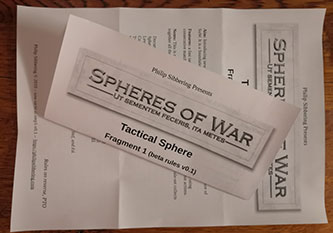Overview
Introducing new Reapers to Spheres of War. The first sheet covers the basic structure of SoW. It is a foundational block, upon which all the later rules are built. SoW is a fast tactical table-top wargame based on Historical Western Martial Arts, using consecutive matches, simultaneous movement, chained combat, and single roll combat actions.
Download now; sow-tactical-frag1-v0.2
Notice: This is not a full game. This Fragment is a component part of the full rule-set. The full rule-set collects together all the component parts (Fragments) for a Sphere and compiles them into a single volume. In this case that will be the Tactical Sphere ruleset. This single volume will be offered as a Print on Demand book with explainers, and a simplified PDF. All content will be duplicated on my website, and the simplified PDF will link back to explainers on my website.
The Rules beta v0.2b
Explanations will be added in response to feedback;
Set up;
1-1) 2 Players.
The fragments are for running a new player through the rules in bite sized pieces, and as such it's best one on one. Later on in the rules, there may be more than 2 players fighting it out on the table-top!
1-2) 2 six-sided dice (D6), 1 for each Player. (In a later Fragment we'll switch to D10)
Spheres of War uses D10 throughout the Spheres, be it D10 for Tactical or D100 for Technical duels. D6 are far more common for those not used to playing table-top wargames or RPGs. If they like the fragments, then later we'll switch to D10 after they invest in some new dice.
1-3) A gaming table with a marked play area, min 1' x 1' (a game mat is a good idea)
Flip over a chequers or chess board and use the back. You can buy a 'game mats' form hobby stores. Any marked space will do, as a child I used to play on a Persian carpet (large rug) in front of the fire during winter as it had squares all over it. It doesn't need to be that precise, as long as you know where the edges are, you can mark it out with coins or pebbles at the four corners.
1-4) Two distinct sets of five x 28mm miniatures, to represent the 'combatants', preferably unarmed.
Take 5 miniatures each. In fragment 1 all combatants have the same abilities so it does not matter which miniatures you take, all that matters is that all have the same size base.
If you do not have any miniatures to hand, such as explaining the rules over a beer, then use any set of markers you can lay your hands on. Bottle caps will do, as will beer bottles!
1-5) An imperial rule, or 2" piece of card (about the height of a business card), which can be decorated.
This piece of card will be used to measure out the distance Players can move their miniatures about on the table-top.
1-6) Players set up on opposite sides of the gaming table.
In Fragment 1 is has to be opposite sides. In later rules this can change, especially where there are more than 2 players.
1-7) Set up your combatants within 6” of your side of the play area (6" x 2 = 1', min play area size)
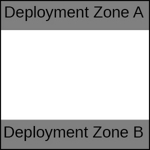
In digram fig 1, the Players set up their miniatures in deployment zone A or B, whichever zone is on their side of the gaming-table.
As the deployment zone is 6" think on the table-top, this means the minimum length of the table-top is 12", or one foot. For fragment 1, the width should be a similar dimension, so 1' x 1'.
In the diagram, the table-top is 2'6" square.
1-8) Players take on the role of Instigator or Retaliator. Flip a coin.
If you win the coin toss, you can chose to be either the Instigator or Retaliator, and your opponent will take on the opposing role.
Turn Organisation;
1-9) The game is divided up into Turns
1-10) Each Turn is made up of a series of Matches.
1-11) All combatants on the table-top are deployed unMatched.
1-12) Matches are between one Instigator and one Retaliator – a Matched pair of opponents.
1-13) The first Match is between the closest unMatched Instigator and unMatched Retaliator.
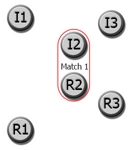
In diagram fig 2 we can see two opposing 3 man teams. This is how they deployed (rule 1-7, on a very small board), and this is the first turn so all are unMatched (rule 1-11).
Notice that it's I2 and R2 that form the first Match. No other opposing combatants are closer together than I2 and R2.
After the Match is formed, all the other combatants are ignored. Concentrate only on this single Match is isolation.
1-14) If several possible Matches are equidistant: Instigator picks which Match to process.
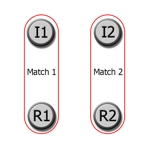
In diagram fig 3 we see two opposing 2 man teams, where both possible Matches are made up of combatants the same distance apart.
I1 and R1 are the same distance from each other as I2 and R2.
In situations like this, it's the Instigator that chooses which Match to process fire. In fig 3 the Instigator has decided the first Match will be between I1 and R1.
1-15) Only Matched opponents can perform Actions.
1-16) Actions are: Wait, Move, and Fight (Move & Auto-hit, and Defend & Auto-hit)
1-17) The Instigator always performs an Action first, followed by the Retaliator's Action in response.
1-18) There are five (5) Actions per Match.
1-19) Once all Actions in a Match are used up, the Match is 'Resolved', and the participants 'Inert'.
1-20) 'Inert' opponents play no further part in the rest of the Turn.
1-21) Create the next Match between the next two closest opponents, ignoring the Inert.
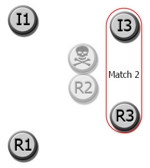
Following on from the first Match in diagram fig 2, we see the results in fig 4: as you can guess from the skull and crossbones it did not go well for I2! R2 has won and I1 has lost. Now this match is resolved it is ignored for the rest of the turn when it comes to making new Matches.
The next Match has to be between the next two closest opposing combatants. In fig 4 this is I3 and R3, and these two will pair up for Match 2.
1-22) The TURN ENDs when all Matches have been resolved, start the next Turn.
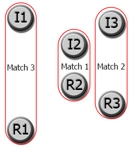
In fig 5 we see the order of Matches based the distance between the opposing combatants. The first Match is between I2 and R2, the second between I3 and R3, and the third between I1 and R1. This is 'serial resolution' in action.
After after all three Matches have been resolved, a new Turn will start.
1-23) A player WINS if there are no enemy combatants on the table.
Movement & Waiting;
1-24) Matched opponents, not in base-to-base contact can only choose 'Wait' or 'Move' Actions.
1-25) The Wait Action means a combatant does nothing for 1 Action.
1-26) The Move Action means you can move your combatant 2” on the tabletop, cost 1 Action.
2" is the same height as a business card. You can use one, or a piece of card cut to size, to measure out each 'step' of movement.
1-27) You can only measure movement after you have chosen to move, min move is 1/4"
1-28) You can move directly towards or directly away from your Matched opponent.
1-29) Moving off the gaming area removes that combatant from the game.
1-30) If Matched opponents come into base-to-base contact are in combat;
1-31) If the Matched opponents fail to make base-to-base contact in a turn they become unMatched.
Combat;
1-32) Any combatants in base-to-base at the beginning of a turn are automatically Matched.
1-33) Once in base-to-base contact both are 'locked in combat' and can only choose 'Fight' Actions.
1-34) The first Fight Action is always 'Move & Auto-hit', to get into contact, and costs 1 Action.
1-35) Subsequent Fight Actions are 'Defend & Auto-hit', while in contact, and also costs 1 Action.
1-36) When counting Actions, count on the 'Moves' and 'Defence Rolls' (ignore Auto-Strikes)
1-37) The Combatant that moves into base-to-base contact with their opponent is the Attacker
1-38) The other Combatant that the Attacker moves into base-to-base contact with is the Defender
1-39) Combat loop start: the Attacker Auto-Strikes the Defender.
Auto-Stikes: it is straightforward to hit a stationary object. If you go down the boxing gym and work the heavy bag, I'll bet that if you throw a hundred punches, you'll hit 100% of the time. If you miss it will because you are distracted, or are so unfit you ran out of steam. These are separate factors from your accuracy. If not distracted and healthy, you Auto-Strike the heavy bag again, and again, and again... It is very easy to hit a heavy bag, and in a fight, it's very easy to hit a person who stands there like a lemon (ignoring the psychology of it all, but that is yet another external factor). It seems reasonable, ignoring distractions, health, moral qualms etc. that your ability to hit is 100% unless the target moves.
Now go and hit a speedball, and once it's all over the place, it is much harder it hit, but it is harder to hit because it is moving, with a slight random element depending on the angle you hit it. In combat your opponent, if they have any instincts, will attempt to move out of the way, and if they have skills they'll be difficult and move at the last second when you punch is in the way, and you cannot change your mind. This puts the success of your strike in the hands of your opponent. You could say: you managed to hit them because they fail to do something about it!
A young fighter is all about blasting and overpowering, faking and forcing ways in. In contrast, an older fighter is patient and sits back, knowing every incoming strike is an opening to take their opponent down fast while their opponent cannot do anything about it. It's only a matter of time before the young fighter reaches too far and over commits. Older fighters are often evasive for that reason (and having less strength). That's not to say a young fighter cannot win, strength does matter, but it's easy for a young fighter to lose if they are not careful, as skill and experience often matter more. Be careful who you throw punches at.
1-40) The only way to override the Auto-hit is with a Martial Art Test, role 1D6;
a) 5-6: Defender fails, is defeated, and is removed from the table-top. The Attacker wins.
b) 1-4: Defender is successful in their defence, and strikes back! The roles are reversed. Return to Rule 1-39
The Defender becomes the Attacker, and this forces the Attacker to become the Defender.
1-41) Keep repeating this process, until one is removed, or all remaining Actions have been used up.
1-42) Any Winners become unMatched, and are free to make Matches next Turn.
To comment, see blog post: Fragment 1 v0.2b
Previous versions: 0.1f,
Connect
If you liked this, and would like to leave a comment on my guestbook, or catch up on all the recent comments, please visit my connect page. While there, you can also subscribe to email notifications, so you never miss a new post, along with my RSS feed as a backup. If you are feeling generous, and I know times are hard, you may support my site through Patreon (exclusive behind the scenes content), PayPal or Bitcoin! Lastly, there is a confidential contact form for any secret messages you wish to pass to me. Thank you for reading, and I look forward to hearing what you have to say :)

